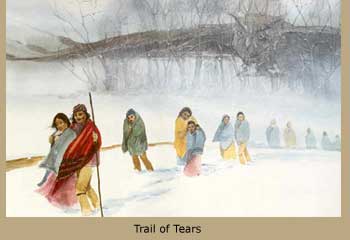 |

Basic Call to Consciousness

Intention

Invented White
History & Imagery

In the Beginning

First Nations Governance

Trail of Tears

Tragedy of
Little Bighorn

Massacre at
Wounded Knee

Duwamish/Suquamish
Displacement

Cultural Genocide

Native Values

Impact of European Immigrants

The Take-over

Called ‘Indian’ or....

Cultural Genocide - Boarding schools

Native Values &
Way of Life

Morality

Depression &
Substance abuse

Cultural Distinctions

Spiritual Sensibilities

Language

Living Two Lives

Leaders or Rulers

Written or Oral

Painful History

Iroquois Conservation

Chief Seattle’s
Farewell Speech

Spirit Road

|
 |

Stories of the Tragedies of First Peoples
Trail of Tears
The Indian Removal Act, part of a U.S. government policy to remove First People from their lands, home to Choctaws in Mississippi Cherokee, Chicksaw, Muscogee & Seminole, was signed into law by President Andrew Jackson on May 28, 1830. The Indian Removal ideology began, however, as early as 1803. The European immigrants in southern states were eager to invade and take over the land upon which First People, five civilized tribes, had been living peacefully. In fact, the Cherokee Nation had been following Thomas Jefferson’s ideal that if the Indians lived in so-called civilized ways like the white man, they could live freely on their land. In Georgia, much pressure was placed on the Cherokee Nation to sign over their land to the government. This was because the whites were covetous of the wealth that cotton could bring them--the cotton was on the Native land. Only a few white people opposed such removal legislation.

Since first contact with European explorers in the 1500s, the Cherokee Nation has been recognized as one of the most progressive among American Indian tribes. Before contact, Cherokee culture had developed and thrived for almost 1,000 years in the southeastern United States--the lower Appalachian states of Georgia, Tennessee, North and South Carolina, and parts of Kentucky and Alabama.

Migration from the original Cherokee Nation began in the early 1800s as Cherokees, wary of white encroachment, moved west and settled in other areas further from the Europeans. White resentment of the Cherokees had been building as other needs were seen for the Cherokee homelands. In 1823 the Supreme Court handed down a decision which stated that Indians could occupy lands within the United States, but could not hold title to those lands. This was because their “right of occupancy” was subordinate to the United States’ “right of discovery.” One of those needs was the desire for gold that had been discovered in Georgia. Besieged with gold fever, a thirst for expansion, and coveting the cotton profits; the white communities turned on their Indian neighbors and the U.S. Government decided it was time for the Cherokees to leave their land, their farms and their homes with little more than they could carry on their backs.

The displacement of Native People was not wanting for eloquent opposition. Senators Daniel Webster and Henry Clay spoke out against removal. Reverend Samuel Worcester, missionary to the Cherokees, challenged Georgia’s attempt to extinguish Indian title to land in the state, winning the case before the Supreme Court.

Worcester vs. Georgia, and Cherokee Nation vs. Georgia, 1831, are considered the two most influential decisions in Indian law. The opinions challenged the constitutionality of the Removal Act and the US. Government precedent for unapplied Indian-federal law was established by Jackson’s defiant enforcement of the removal. Georgia and the U.S. Government prevailed and used it as justification to force almost all of the 17,000 Cherokees from their southeastern homelands. 
The U.S. Army’s enforcement of the Indian Removal Act rounded up The People, often holding them in prison camps while awaiting their fate. In the middle of winter of 1838-39, 14,000 Native men, women and children were forced to march on foot in the cold elements 1,200 miles through Tennessee, Kentucky, Illinois, Missouri, and Arkansas into rugged Indian Territory.

An estimated 4,000 died from hunger, exposure and disease. The journey became an eternal memory as the “trail where they cried” for the Cherokees and other removed tribes. Today it is remembered as The Trail of Tears.
Click on the rug to return to the top of the page.

 Home Home
 Quiz Quiz
 About Author About Author

|
![]() ©2015 Lilthea Designs
©2015 Lilthea Designs